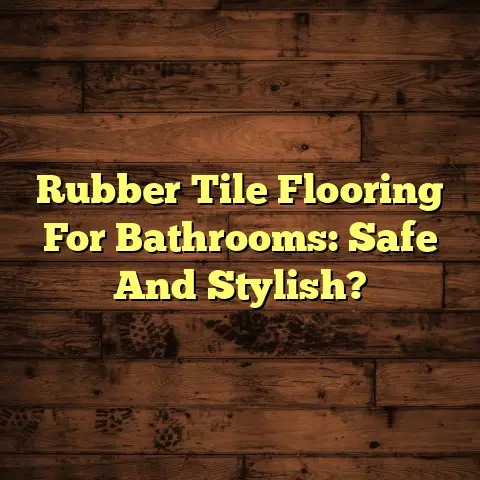Fix Creaking Floor Joists (8 Quick Solutions!)
Ah, fall!
The season of pumpkin spice, cozy sweaters, and the crunch of leaves underfoot.
But what about the crunching inside your house?
Specifically, the infuriating creak of your floor joists?
Believe me, as a flooring contractor for over 20 years, I’ve heard my fair share of creaky floor complaints.
It’s not just a nuisance; it can be a sign of underlying issues.
Let’s dive into understanding, diagnosing, and tackling those pesky creaks!
Understanding Creaking Floor Joists
What are Floor Joists?
Think of floor joists as the backbone of your floor.
They’re horizontal beams, usually made of wood, that support the subfloor (the layer directly under your finished flooring).
They transfer the weight of everything in your room – furniture, people, even that massive bookshelf you love – to the foundation of your house.
Without them, well, you’d be living in a very unstable situation!
Why Do They Creak?
Over time, several factors can contribute to creaky floor joists:
- Age: Like us, houses age. Materials dry out, warp, and lose their original tightness.
- Humidity & Temperature Changes: Wood expands and contracts with moisture and temperature fluctuations.
This constant movement can loosen fasteners and cause friction. - House Settling: All houses settle over time.
This natural process can put stress on the floor joists. - Material Type: Different wood species have different properties.
Softer woods are more prone to wear and tear.
According to the USDA Forest Service, wood moisture content (MC) is a critical factor.
Ideally, interior wood should have an MC of 6-12%.
When it fluctuates outside this range, problems arise.
Implications of Ignoring Creaks
Ignoring those creaks might seem harmless, but it can lead to bigger problems:
- Safety Concerns: Severely weakened joists can compromise the structural integrity of your floor.
- Flooring Damage: Constant movement can damage your finished flooring, leading to cracks, gaps, or even complete failure.
- Increased Costs: Addressing the problem early is always cheaper than dealing with extensive repairs later.
Solution 1 – Tightening Floor Joist Screws and Nails
This is often the first and easiest fix.
Loose fasteners are a common culprit behind creaks.
Tools and Materials You’ll Need
- Screwdriver (Phillips and flathead)
- Hammer
- New screws (matching the existing ones)
- Nail set
- Safety glasses
Step-by-Step Guide
- Locate the Creak: Have someone walk over the creaky area while you’re in the basement or crawl space.
Pinpoint the exact location of the creak. - Inspect for Loose Fasteners: Look for screws or nails that are sticking out or appear loose around the creaking area.
- Tighten Screws: Use the appropriate screwdriver to tighten any loose screws.
If the screw spins without tightening, it might be stripped.
Replace it with a slightly longer screw. - Hammer in Nails: If nails are loose, use a hammer to drive them back in.
Use a nail set to avoid damaging the surrounding wood. - Reinforce Weak Points: If you find multiple loose fasteners in the same area, consider adding extra screws for reinforcement.
Safety Precautions
- Always wear safety glasses to protect your eyes from debris.
- Be careful when working overhead to avoid dropping tools.
- If you’re unsure about the structural integrity of the joists, consult a professional.
Solution 2 – Adding Friction Between Joists and Subfloor
Sometimes, the creak isn’t from loose fasteners but from the subfloor rubbing against the joists.
What is Adding Friction?
It involves inserting materials between the joists and subfloor to create a tighter fit and reduce movement.
Materials You Can Use
- Shims: Thin, tapered pieces of wood.
- Foam Strips: Self-adhesive foam strips.
- Construction Adhesive: Applied in small beads to fill gaps.
Step-by-Step Guide
- Locate the Gap: Identify the area where the subfloor is rubbing against the joist.
- Insert Shims: Gently tap shims into the gap between the joist and subfloor.
Be careful not to force them too much, as this could lift the subfloor. - Apply Foam Strips: Peel off the backing of the foam strips and stick them to the top of the joist where it contacts the subfloor.
- Test for Creaks: Have someone walk over the area to see if the creak is gone.
Add more shims or foam strips if needed.
Solution 3 – Installing Blocking
Blocking involves adding short pieces of wood between the joists to provide extra support and prevent them from twisting or moving independently.
What is Blocking?
It’s like adding extra “ribs” to your floor structure.
It helps distribute weight and stiffen the floor.
Tools and Materials You’ll Need
- Measuring tape
- Saw
- Wood (same dimensions as your joists)
- Drill
- Screws
Detailed Guide
- Measure the Distance: Measure the distance between your joists.
This will be the length of your blocking pieces. - Cut the Blocking: Cut the wood into pieces of the correct length.
- Install the Blocking: Place the blocking pieces between the joists, perpendicular to them.
- Secure the Blocking: Use screws to attach the blocking to the joists.
Drill pilot holes first to prevent the wood from splitting. - Space the Blocking: Install blocking every 4-8 feet along the length of the joists.
Solution 4 – Using Construction Adhesive
Construction adhesive is a strong, flexible glue that can help bond the subfloor to the joists, reducing movement and creaks.
How it Works
It fills in gaps and creates a solid connection between the wood surfaces.
Step-by-Step Guide
- Locate the Creak: As before, pinpoint the source of the creak.
- Apply Adhesive: Use a caulking gun to apply a bead of construction adhesive along the top of the joist where it contacts the subfloor.
- Press Together: If possible, use clamps or weights to press the subfloor against the joist while the adhesive dries.
- Drying Time: Allow the adhesive to dry completely according to the manufacturer’s instructions.
This usually takes 24-48 hours.
Safety Measures
- Wear gloves to protect your hands from the adhesive.
- Work in a well-ventilated area.
- Avoid getting adhesive on your skin or clothing.
Solution 5 – Adding Sister Joists
Sistering involves attaching a new joist alongside an existing one to reinforce it.
This is a more involved solution, but it can be very effective for severely weakened joists.
What are Sister Joists?
They’re like giving your joists a “twin” for extra support.
Tools and Materials Needed
- Measuring tape
- Saw
- Wood (same dimensions as your existing joists)
- Drill
- Screws or construction adhesive
- Clamps
Comprehensive Guide
- Measure the Existing Joists: Measure the length and width of your existing joists.
- Cut the Sister Joists: Cut the new wood to the same dimensions as the existing joists.
- Attach the Sister Joists: Place the sister joist alongside the existing joist.
- Secure the Sister Joists: Use screws or construction adhesive to attach the sister joist to the existing joist.
Space the screws every 12-16 inches. - Clamp Together: Use clamps to hold the sister joist in place while the adhesive dries or while you’re driving in the screws.
Safety Considerations
- Make sure the sister joist is properly aligned with the existing joist.
- Use enough screws or adhesive to ensure a strong connection.
- If you’re working on a load-bearing wall, consult a professional before adding sister joists.
Solution 6 – Adjusting the Floor Supports
Sometimes, creaks are caused by sagging joists due to inadequate support.
Importance of Proper Support
Joists need to be properly supported by beams or posts.
If these supports are sagging or have settled, it can cause the joists to flex and creak.
How to Inspect and Adjust
- Locate the Supports: Find the support beams or posts under the joists in the basement or crawl space.
- Check for Sagging: Use a level to check if the supports are level.
If they’re sagging, you’ll need to adjust them. - Adjust the Supports: If the supports are adjustable, use a wrench to raise them until they’re level.
If they’re not adjustable, you may need to add shims or replace the supports.
Step-by-Step Guide
- Use a Jack: If necessary, use a jack to lift the joists slightly before adjusting the supports.
- Add Shims: If the supports are too low, add shims between the support and the joist to raise it.
- Replace Supports: If the supports are damaged or deteriorated, replace them with new ones.
Solution 7 – Using a Creaking Floor Kit
Creaking floor repair kits are available at most home improvement stores.
They typically include screws, shims, and sometimes adhesive, along with detailed instructions.
What’s in a Kit?
- Specialized screws designed to pull the subfloor tight to the joists.
- Shims for filling gaps.
- Applicator tools for easy installation.
How to Use a Kit
- Follow the Instructions: Read the instructions carefully before starting.
- Locate the Creak: Identify the source of the creak.
- Install the Screws: Use the applicator tool to drive the screws through the subfloor and into the joist.
- Fill Gaps: Use shims to fill any gaps between the subfloor and joist.
Advantages and Drawbacks
- Advantages: Convenient, easy to use, and relatively inexpensive.
- Drawbacks: May not be effective for severe creaks or structural problems.
Solution 8 – Calling in a Professional
Sometimes, DIY solutions just aren’t enough.
If you’ve tried the above methods and the creaks persist, or if you suspect structural damage, it’s best to consult a professional.
When to Call a Pro
- If you’re uncomfortable working in your basement or crawl space.
- If you suspect structural damage.
- If you’ve tried DIY solutions and they haven’t worked.
What to Look for in a Contractor
- Experience and expertise in floor repairs.
- Positive reviews and references.
- Proper licensing and insurance.
Benefits of Professional Intervention
- Accurate diagnosis of the problem.
- Effective and long-lasting solutions.
- Peace of mind knowing the job is done right.
Conclusion
Creaking floor joists can be a real pain, but with the right knowledge and tools, you can often fix them yourself.
Remember to start with the simplest solutions first and work your way up to more complex ones.
And if you’re ever in doubt, don’t hesitate to call in a professional.
A little effort can restore peace and quiet to your home, allowing you to fully enjoy the comforts of the season.
So, go ahead, tackle those creaks and get back to enjoying the cozy atmosphere of your home!





